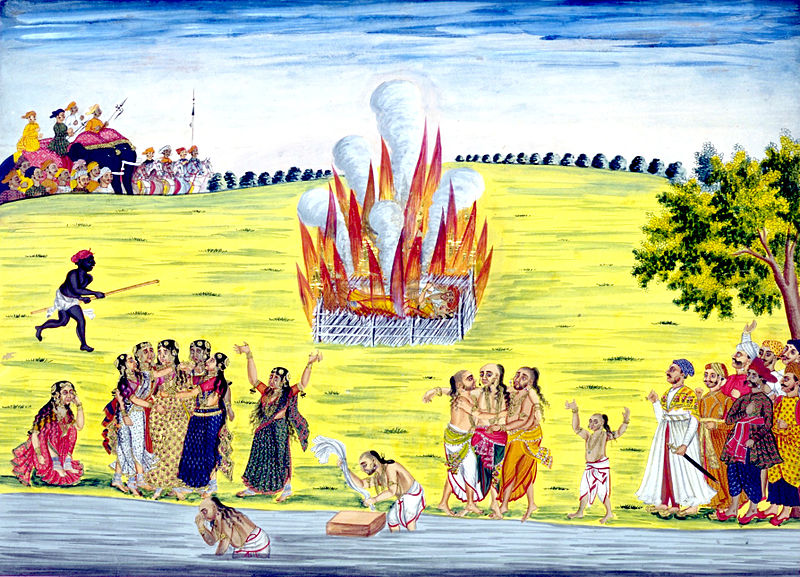Sati, also known as “Suttee,” was a tradition that was practiced in ancient India from the early centuries BCE to the mid-1990’s. In this tradition, widows were burned at the side of their deceased husbands. There were many reasons behind this tragic form of suicide, but the act was seen as heroic and courageous. The tradition originates with the goddess Sati, who burned herself to death in a fire that she created through her yogic powers, which she obtained after her father had insulted her husband. Sati became an option for women in India who were not “marriageable,” according to social norms. Sati was first recognized in the Mahabharata, one of the two most well-known and important poems of India.1
“LAMP of my life, the lips of Death
Hath blown thee out with their sudden breath;
Naught shall revive thy vanished spark . . .
Love, must I dwell in the living dark?” -Suttee by Sarojini Naidu2
The practice of Sati is recounted by a first century BCE Greek author named Diodorus Siculus. Diodorus mentioned sati stones, which were memorials of all of the wives that have passed along with their husbands. A stone was created for each wife after she gave up her life, and these stones were all collected into a shrine. The earliest memorial that has been discovered dates from 510 BCE.3

Another practice that branched out from sati was the Jahuar, which was a sacrifice of any Muslim woman from the twelfth through the sixteenth century. It was believed that if a woman was burned, she would be safe from rape, which was worse than dying at the hands of a conquering enemy.4
Sati was also practiced by the Brahmans of Bengal, by the system of law from 1100 CE, which was called Dayabhaga. If a woman was widowed, her inheritance would be given to the children of her passed husband. If she were to remarry, her inheritance from her deceased husband would be given to the children and her new husband and her other children would not receive anything. If she passed along with her husband, the inheritance would be given to the children of her dead husband. This law was ended by the Mughal rulers Akbar and his father Humayun in the sixteenth century.5
In 1829, when India was informally ruled by Great Britain, the law to make sati illegal was passed because the act was seen by the British as harsh and cruel to women. Although it was made illegal, there were controversies over whether the sati practice was a religious act, and if so, should that be taken into consideration before prohibiting it.2
In 1987, Roop Kanwar, a woman from the village of Deorala in Rajasthan India, was married to her husband for only eight months before he died. She decided against taking her life in front of thousands of people. Politicians and activists believed that Roop Kanwar was then subsequently drugged by the liquid inside the seeds of an opium poppy flower, and pressured to take her life by those around her. Some people even say that she had super natural powers because her eyes were glowing bright red as she burst into flames. Police concluded that a group of men had been guilty of having drugged her, and they were placed under arrest.7
Sati was a rather harsh tradition, but the significance of these rituals was important to many Indian traditions. The thought of self sacrifice in this way is foreign to Western traditions, and the thought of being burned alive is worse. Sati is now illegal and no longer practiced, but the memories of the dead women from this tradition remain and they will always remind us of this social practice.8
- Kashgar, 2009, s.v. “Life in India: the practice of sati or widow burning,” by Linda Heaphy. ↵
- The Denson Journal of Religion, April 2015, s.v. “Interpreting Sati: the Complex Relationship Between Gender and Power in India,” by Cheyenne Cierpial. ↵
- Dorothy Stein, Burning Widows (University of British Columbia: Pacific Affairs, 1988), 466. ↵
- The Denson Journal of Religion, April 2015, s.v. “Interpreting Sati: the complex Relationship Between gender and Power in India,” by Cheyenne Cierpial. ↵
- Encyclopedia Britannica, March 2015, s.v. “Suttee,” by Wendy Dongiger. ↵
- The Denson Journal of Religion, April 2015, s.v. “Interpreting Sati: the Complex Relationship Between Gender and Power in India,” by Cheyenne Cierpial. ↵
- Encyclopedia Britannica March 2015, s.v. “Suttee,” by Wendy Dongiger. ↵
- Sophia Gilmartin, “The Sati, the Bride and the Widow: Sacrificial Woman in the nineteenth century,” Victorian Literature Vol. 25, No.1 (1997): 142. ↵



99 comments
Celeste Flores
This whole reading really got me thinking about Cultural Relativism. Even though I do not agree with the practices they had, in the past it was normal for them, it was a tradition. One common thing that most of the ancient cultures have in common is the sacrifice of women. I find it really interesting how they viewed women as something precious and sacred and most of the time they were subject to harsh practices.
Abigale Carney
After reading this article, I was shocked by the odd and sickening rituals of this time period. I do not understand how one could be okay with allowing a woman to burn with her husband. It seems very strange because if the woman is healthy, there should be no reason to sacrifice her own life for one who has already passed. I am very grateful for our growth throughout history, allowing women to have a greater influence in communities so situations such as this never have to occur again.
Amelia Hew
It is sad and frustrating to know that women from that time were forced to commit suicide just because of the death of their husbands. I mean like women are humans too so why don’t they have the rights to decide their own fate? Thanks to history, we are able to realize the mistakes done in the past and correct them to build a more civilized community. I believe that history is a window of the past that allows us to see different situations in different perspectives and prevents us from making the same mistakes our ancestors did.
Eric Ortega Rodriguez
This sounds like a very weird custom to some of us. However, just as the author mentions it, this is what they saw as the norm and as there traditions. I found it interesting that during the time when India was under Britain’s rule and made Sati illegal, there were still individuals who believe it was not correct considering it was a religious act. Overall, this was a very interest topic selection and was very well written. Great work.
Averie Mendez
It seems a bit extreme to burn yourself alive following the death of your husband. To implement such rituals or traditions in a culture is a bit barbaric and inhumane, especially if the entire community was present to watch the woman burn. I’m glad this is no longer practiced and laws have been implemented to prevent people from continuing this further. The case in 1987 is very tragic and I hope she rests in peace.
Yazmin Garza
If the widows were forced into being burned with their husbands, then I feel a lot of sympathy for them, but if they weren’t then I see it as a grand and final romantic gesture, even though I know that most of the time it probably was not an action that was done by choice. I wonder if some people are still practicing Sati, and if there are any legal issues with those who voluntarily participate.
Sarma
Sir, it is not hindu tradition, please refer and give example of sati deaths(other than madrid, pandu raja from Mahabharata. In ramayana all 3 wife’s are alive after dasaratha raja death, and in mahabharatam mother of Bhishma is alive after death of her husband).
It is not hindu culture also , but can tell it is helplessness to escape from enemy torture from 11th century. That poor life my hindu ladies faced rather than surrendering.
Victoria Rodriguez
Being a woman in 2018, it is insulting to know tat traditions like these were for woman who were unmarriageable. Of course, that is my opinion from 2018, but I am sure that women who participated in this tradition were very concerned with their wellbeing if their husband died. Perhaps their living situation was going to change so drastically that it would just be better to die with your husband. Either ways, this is a great article on a messed up tradition. Symbolically, I get it realistically, it is terrible.
Ximena Mondragon
This article is very interesting but it is so angering and sad of such traditions. For centuries traditions have hurt women one way or another. I would like to know if in all cases the women voluntarily decided to be burned or was it against their will. If it was against their will or due to societal pressure wouldn’t that be considered murder.
Andrea Cabrera
The article is very informative and educative on the beliefs of another entirely different culture, even if this idea is no longer practiced. It heartbreaking to think women in this world once believed they deserved such punishment for not seen as “marriageable.” Women are valuable, and it is an excellent accomplishment that this practice is no longer allowed. Societies have done their best to progress to give woman the rightful place of been seen as equal to man and not just their companion.